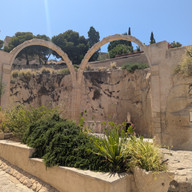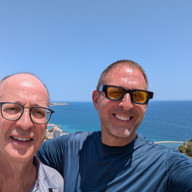🎵 (We gonna rock down to) Hogueras Avenue 🎵
- michaellatour
- Jul 9
- 3 min read
During the month of July we are catching up with friends and family in the U.S. and Canada. But I couldn’t leave Spain and Alicante behind without telling you about our last full weekend there….
The Festival de Hogueras de San Juan

There used to be a local tradition that on June 23rd one would dine outdoors with their neighbors, light bonfires, and celebrate life. In 1928, Jose Maria Py proposed turning the bonfires into sculptures that would get set ablaze- satirical, political, and/or socially critical sculptures. This evolved into each neighborhood producing a sculpture (or, Hoguera) to compete for the title of the best in the city. The winner is enshrined in the Hogueras Museum, while the rest are set on fire the night of the 24th. This Festival TAKES OVER Alicante for four days.
Our first inkling that something was afoot was one evening about week earlier, when the main avenue we crossed daily was suddenly blocked for parade preparation. That first parade was filled with children, local musicians, and folks in traditional dress. At this first parade, we discovered that there was an underground parking garage under this main avenue; so, we found access stairs and cut across the garage to get to the other side. This garage became very important, because this was only the first of many, many, many parades.
About two days before the festival was set to begin, it felt like the city’s population suddenly tripled in size. Tourists from all over Spain arrived en masse, and walking the streets became an exciting adventure. In addition, at least half of the roads were suddenly closed to traffic, and fencing started going up in some blocks, as impromptu outdoor ‘restaurants’ were created in the streets.
Next, people from the neighborhoods started assembling their Hogueras (is this the plural too? 🤷). Photos cannot capture the size, scope, and details of these temporary sculptures. We wandered the city looking at so many of them, in awe. Then, the fireworks started. At 2pm every day for four days, a cacophony of noise erupted in the middle of the city. Because it’s daylight, it’s not about the light of the fireworks… it’s about the NOISE. And it’s loud!
Thus, for four days people stroll the streets while eating, drinking, sometimes dancing to the traveling bands of musicians (our morning alarm each day of the festival), and navigate the maze of fencing to check out each neighborhood’s sculptures.
On the final night, the winning sculpture is crowned. At midnight there is a fireworks explosion at the peak of Castillo de Santa Barbara, and every Hogueras throughout the city is (aside from the winner) set ablaze.
We left our apartment that evening around 11:45 and caught the fireworks at the castle, but as we walked the surrounding streets, the four or five closest sculptures remained intact. Members of the community surrounded them for photos and celebration. Around 1:00am we questioned whether we were wrong about them being set on fire and gave up and went home. We later learned that the ones in our area were lit around 2:30am, long after we’d gone to sleep.
Castillo De Santa Barbara
Speaking of the Castillo de Santa Barbara, in the middle of the chaos of the holiday weekend we decided that it might be a good time to visit Alicante’s most iconic point. The castle overlooks the whole city. We thought that, with everyone distracted by the festivities, it might be less crowded than normal… and we were right!
The castle sits about 550 feet above the city. Elements of the existing structure date back to the 9th century, with the bulk of it being built during two expansions- one in the 1200s and one in the 1500s. Archeological evidence suggests that prior to the existing structure, other defensive forts have sat on the site, dating all the way back to the Bronze Age.
Perched as it is above the city, its not only a great structure to explore, but it also provides sweeping views of the Mediterranean coast. In addition, they sometimes have special exhibits, such as the one we stumbled upon that featured musical instruments from the 17th- 19th centuries.
Best of all, visiting this historic site is free.
.png)



















































Comments